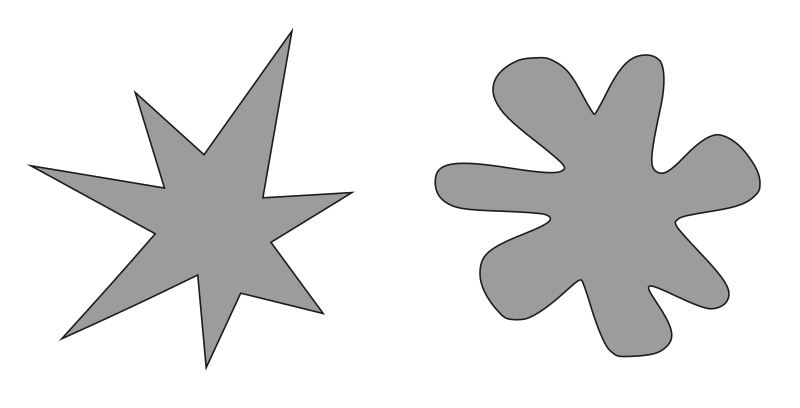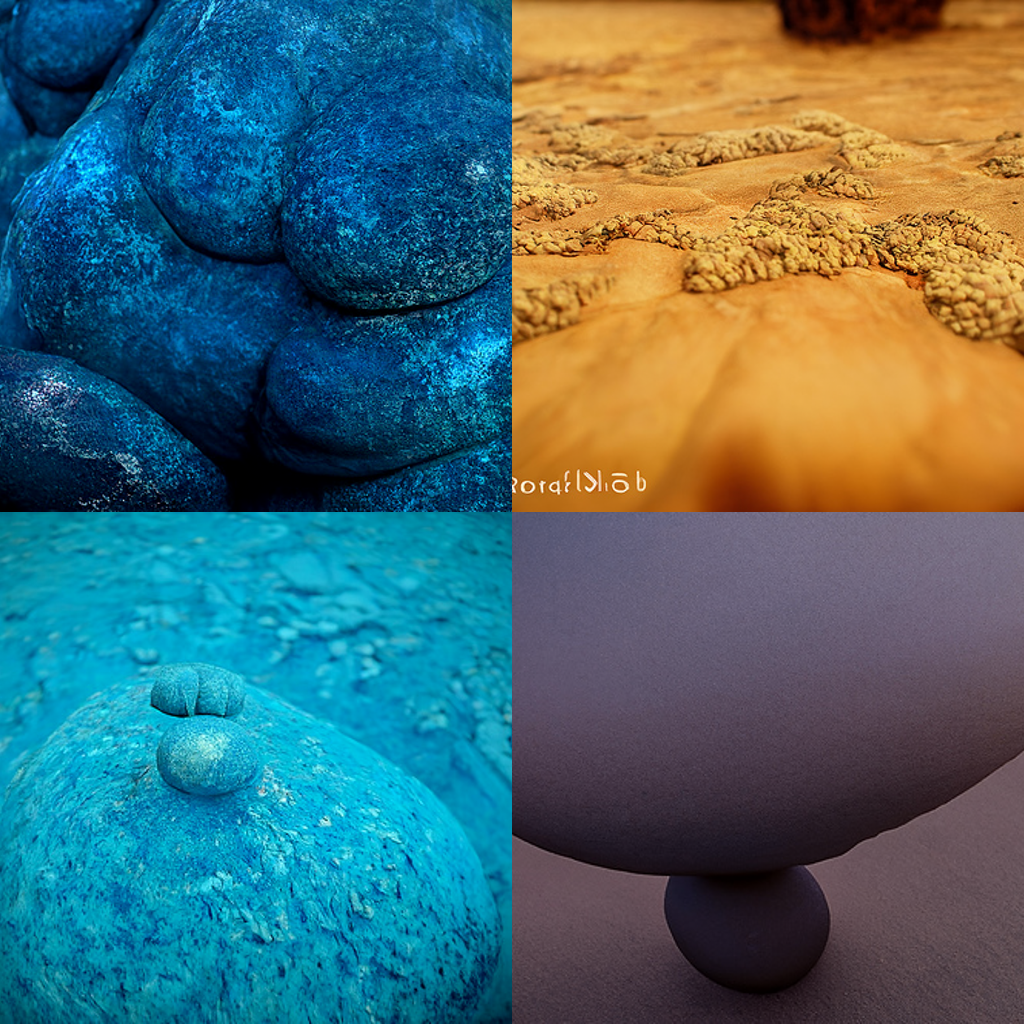The bouba/kiki effect is the phenomenon where humans show a preference for certain mappings between shapes and their corresponding labels/sounds.

The above image of 2 theoretical objects is shown to a participant who is then asked which one is called a ‘bouba’ and which is called a ‘kiki’. The results generally show a strong preference (often as high as 90%) for the sharply-pointed object on the left to be called a kiki, with the more rounded object on the right to be called a bouba. This effect is relatively universal (in languages that commonly use the phonemes in question), having been noted across many languages, cultures, countries, and age groups (including infants that have not yet learned language very well!), although is diminished in autistic individuals and seemingly absent in those who are congenitally blind.
What makes this effect particularly interesting is less so this specific example, but that it appears to be a general phenomenon referred to as sound symbolism: the idea that phonemes (the sounds that make up words) are sometimes inherently meaningful rather than having been arbitrarily selected. Although we can map the above two shapes to their ‘proper’ labels consistently, we can go much further than just that if desired.

We could, of course, re-draw the shapes a bit differently as well as re-name them: the above image is a picture of a ‘maluma’ and a ‘takete’. If you conformed to the expectations in the first image of this section, it’s likely that you feel the maluma is the left shape in this image as well.
We can ask questions about these shapes that go far beyond their names too; which of these shapes is more likely to be calm, relaxing, positive, or explanatory? I would certainly think the bouba and maluma are all four of those, whereas the kiki and takete seem more sharp, quick, negative, or perhaps even violent. If I was told that the above two shapes were both edible, I can easily imagine the left shape tasting like sweet and fluffy bread or candy, while the right may taste much more acidic or spicy and possibly have a denser and rougher texture.
Sound symbolism
The idea that large sections of our languages have subtle mappings of phonemes to meaning has been explored extensively over time, from Plato, Locke, Leibniz, and modern academics, with different figures suggesting their theorized causes and generalizations.
Some of my favorite examples of sound symbolism are those found in Japanese mimetic words: the word jirojiro means to stare intently, kirakira to shine with a sparkle, dokidoki to be heart-poundingly nervous, fuwafuwa to be soft and fluffy, and subesube to be smooth like soft skin. These are some of my favorite words across any language due to how naturally they seem to match their definitions and how fun they are to use (more examples because I can’t resist: gorogoro may be thundering or represent a large object that begins to roll, potapota may be used for dripping water, and kurukuru may be used for something spinning, coiling, or constantly changing. There are over 1,000 words tagged as being mimetic to some extent on JapanDict!).
For fun I asked some of my friends with no prior knowledge of Japanese some questions about the above words, instructing them to pair them to their most-likely definitions, and their guesses were better than one would expect by random chance (although my sample size was certainly lacking for proper scientific rigor). The phonestheme page on Wikipedia tries to give us some English examples as well, such as noting that the English “gl-” occurs in a large number of words relating to light or vision, like “glitter”, “glisten”, “glow”, “gleam”, “glare”, “glint”, “glimmer”, “gloss”. It may also be worth thinking about why many of the rudest and most offensive words in English sound so sharp, often having very hard consonants in them, or why some categories of thinking/filler words (‘hmm’… ‘uhhh…’) sound so similar across different languages. There are some publications on styles of words that are found to be the most aesthetically elegant, including phrases such as ‘cellar door’, noted for sounding beautiful, but not having a beautiful meaning to go along with it.
Sound Symbolism in Machine Learning with CLIP
I would guess that many of the above aspects of sound symbolism are likely to be evident in the behavior some modern ML models as well. The reason for this is that many recent SOTA models often heavily utilize transformers, and when operating on text, use byte-pair encoding (original paper). The use of BPE allows the model to operate on textual input smaller than the size of a single word (CLIP has a BPE vocab size of 41,192), and thus build mappings of inputs and outputs between various subword units. Although these don’t correspond directly to phonemes (and of course, the model is given textual input rather than audio), it’s still likely that many interesting associations can be found here with a little exploration.
To try this out, we can use models such as CLIP+VQGAN or the more recent CLIP-guided diffusion, prompting them to generate an image of a ‘bouba’ or a ‘kiki’. One potential issue with this is that these words could have been directly learned in the training set, so we will also try some variants including making up our own. Below are the first four images of each object that resulted.


The above eight images were created with the prompt “an image of a bouba | trending on artstation | unreal engine”, and the equivalent prompt for a kiki. This method of prompting has become popular with CLIP-based image generation models, as you can add elements to your prompt such as “unreal engine” or “by Pablo Picasso” (and many, many others!) to steer the image style to a high-quality sample of your liking.
As we anticipated, the bouba-like images that we generated generally look very curved and elliptical, just like the phonemes that make up the word sound. I have to admit that the kiki images appear slightly less, well, kiki, than I had hoped, but nonetheless still look cool and seem to loosely resemble the word. A bit disappointed with this latter result, I decided to try the prompt with ‘the shape of a kikitakekikitakek’ instead, inserting a comically large amount of sharp phonemes all into a single made-up word, and the result couldn’t have been better:

Having inserted all of the sharpest-sounding phonemes I could into a single made-up word and getting an image back that looks so amazingly sharp that it could slice me in half was probably the best output I could have hoped for (perhaps I got a lucky seed, but I just used 0 in this case). We can similarly change the prompt to add “The shape of” for our previous words, resulting in the shape of a bouba, maluma, kiki, and takete:

It’s cool to see that the phoneme-like associations within recent large models such as CLIP seem to align with our expectations, and it’s an interesting case study that helps us imagine all of the detail that is embedded within our own languages and reality – there’s a lot more to a word than just a single data point. There’s *a lot* of potential for additional exploration in this area and I’m definitely going to be having a lot of fun going through some similar categories of prompts over the next few days, hopefully finding something interesting enough to post again. If you find this topic interesting, some words you may want to search for along with their corresponding Wikipedia pages include: sound symbolism, phonestheme, phonaesthetics, synesthesia, ideathesia, and ideophone, although I’m not currently aware of other work that explores these with respect to machine learning/AI yet.
Thanks for reading! I appreciate feedback via any medium including email/Twitter, for more information and contact see my about page